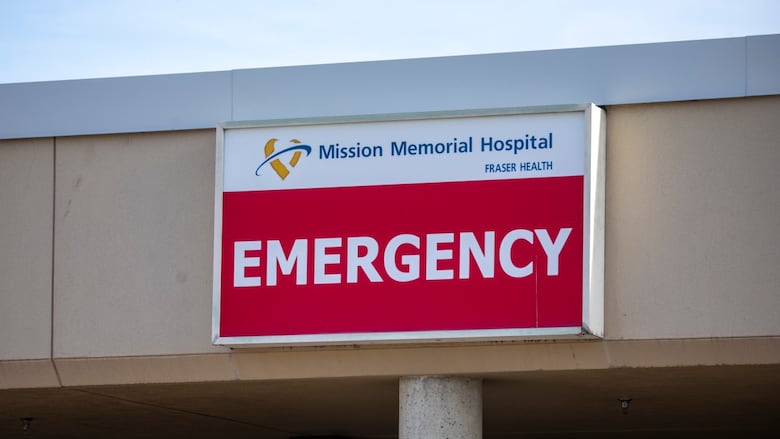Data reveals dramatic spike in patients leaving B.C. emergency rooms without receiving care
Increases most pronounced in Fraser Health and Vancouver Island Health authorities

Provincial data obtained through a freedom-of-information request reveals that the number of patients in B.C. leaving emergency rooms without receiving care has spiked by 86 per cent — with the largest increases seen in the Fraser Health and Vancouver Island Health authorities.
The data reveals the number of unscheduled visits to emergency rooms across B.C.'s health authorities between 2018 and 2025, and breaks down patient visits by their Canadian triage and acuity scale (CTAS) — a system used to categorize patients based on the urgency of their case.
It also includes another category of patients titled: Left Without Being Seen (LWBS).
According to the numbers compiled by the B.C. Ministry of Health, in the 2018-2019 fiscal year, 76,157 patients in B.C. left emergency rooms without receiving care.
By 2024-2025, that number grew to 141,961.
When broken down by health authority, the numbers show that, in some regions, cases of LWBs worsened significantly in the past two years.
Across B.C., the number of patients that left emergency rooms without receiving care grew 18 per cent between 2023 and 2025.
In a statement, the Ministry of Health said that B.C., like other jurisdictions in Canada, "is experiencing higher emergency department (ED) volumes and higher acuity patients in hospitals."
"When patients first arrive at the ED, they are triaged and seen based on acuity. The sickest patients are always seen first. Patients are never turned away from the ED. The number of patients that leave the ED without being seen is a small proportion of the total number of visits to the ED. In general, patients with lower acuity levels are more likely to leave the ED without seeing a physician."
'Significantly outside acceptable range'
The Vancouver Island Health Authority saw a particularly large increase in patients who left before they received care, with 11,513 cases recorded in 2018-2019, 20,925 cases recorded in 2023-2024, and 29,997 cases recorded in 2024-2025. That represents growth of 160 per cent over seven years.
An Island Health authority document on performance measures published in January 2025 said that while the authority's target for LWBs is two per cent, it was currently seeing 7.3 per cent of patients leave before seeing a physician.
"As of November 2024, Island Health was not meeting the target for this measure," says the document.
"Performance is significantly outside acceptable range."
The document says that "occasionally, people who seek care at Emergency Departments are registered and receive a triage assessment from a nurse, but then they leave the Emergency Department (ED) before seeing a physician."
"If a person sought care at an ED, but left before seeing a physician, it is possible they did not receive the care they needed."
The document also notes the factors contributing to the high rate, noting "increased Emergency arrivals and inpatients being held in an Emergency location contribute to crowding and longer wait times to see a physician. When Emergency visits and crowding increase, the rate worsens [increases]."
The population served by Island Health grew by 11 per cent between 2018 and 2024, according to Statistics Canada.

In the Fraser Health Authority, the largest health authority in B.C., there were 34,678 LWBs recorded in 2018-2019.
That number jumped to 55,415 in 2023-2024, and spiked to 64,972 in 2024-2025, representing overall growth of 87 per cent.
Fraser Health's population also grew by around 4.6 per cent during that time, according to B.C. Stats. The population in the health authority is expected to grow by 32 per cent over the next 15 years.
The Vancouver Coastal Health Authority recorded 13,353 LWBs in 2018-2019, up to 21,475 in 2023-2024, and a slight dip to 20,898 in 2024-2025.
The province said to address long wait times, B.C. increased the number of provincially-funded acute care beds from 9,202 to 9,929 beds, a rise of 7.9 per cent.
It said Island Health successfully recruited nearly 1,800 net new employees in 2024, including more than 800 new nurses.
In a statement, B.C.'s opposition Conservatives called the figures "devastating."
Data backs patient stories
The data comes after a series of high-profile stories about deteriorating conditions in B.C. emergency rooms, that described lengthy wait times, undignified conditions for patients and their families, and violent attacks against medical staff.
Emergency room physician Kaitlin Stockton launched an explosive lawsuit against the Fraser Health Authority in June, alleging her job was threatened after she tried to warn patients of "unacceptable" wait times.

Two nurses in the same health authority also came forward detailing brutal attacks they say they suffered at the hands of patients while working in B.C. emergency rooms.
In an interview with CBC following the two stories, Health Minister Josie Osborne said the province is currently undertaking a review of every health authority in B.C.
In a statement, Doctors of B.C., which represents over 16,000 physicians, residents, and medical students, said it "has been calling for the creation of an emergency department stabilization plan for some time."
"Physician shortages are also impacting emergency departments, and recent efforts to recruit U.S. physicians and the new SFU medical school are certainly helpful, but more needs to be done to recruit and retain physicians, nurses, and other health-care professionals to meet the needs of patients," it reads.

